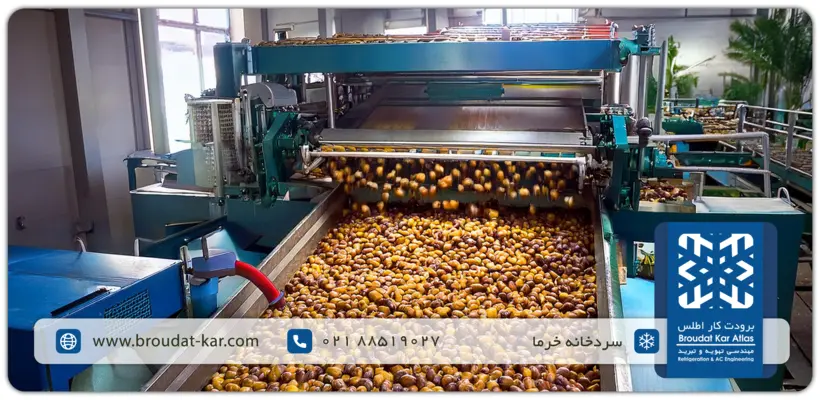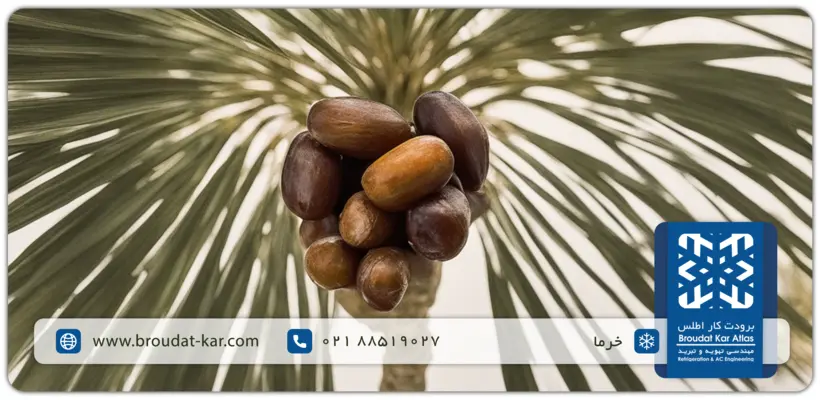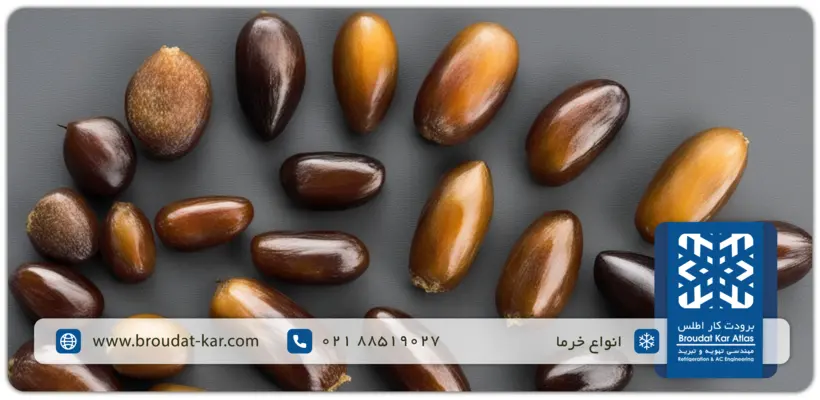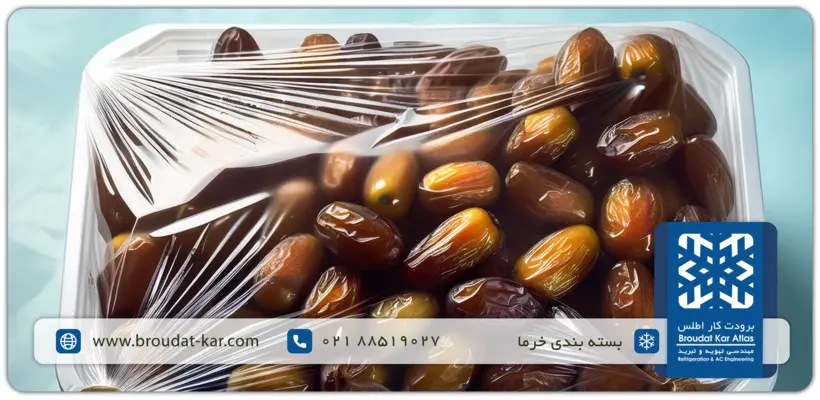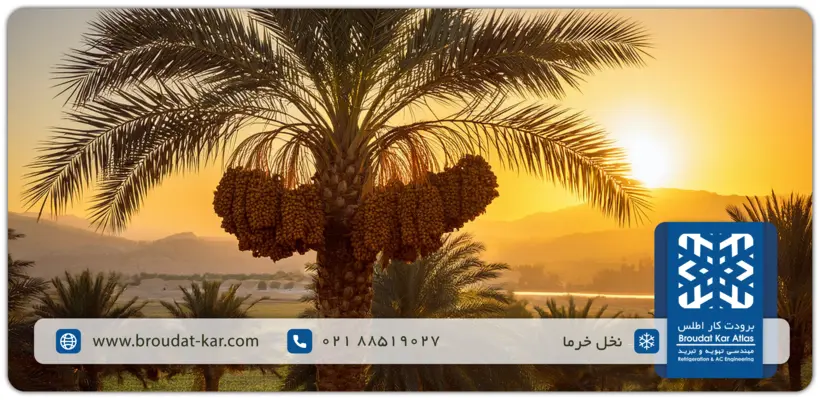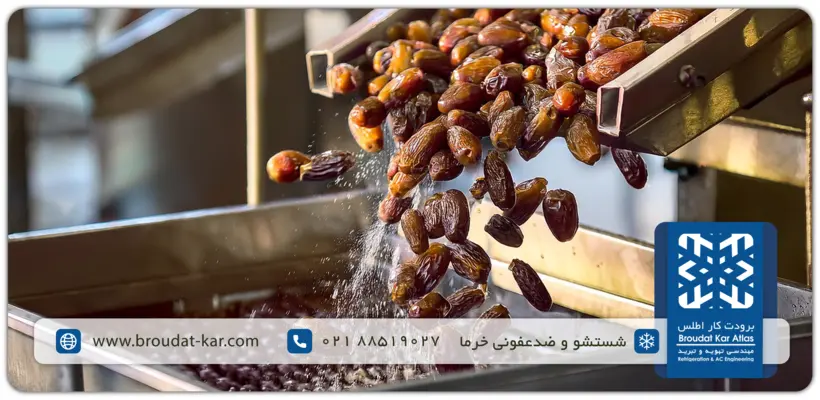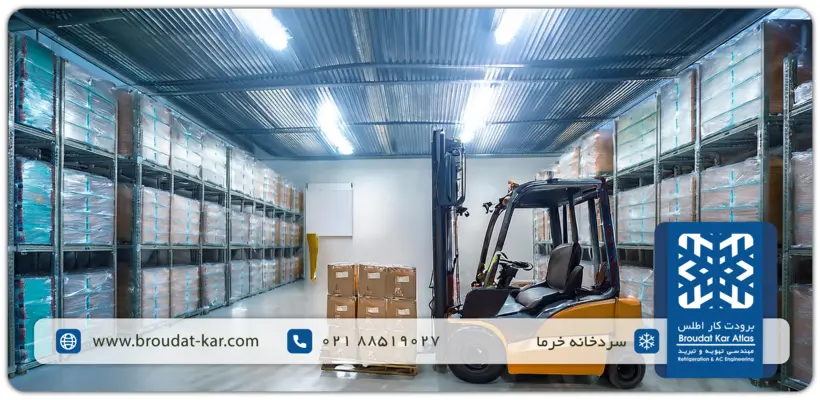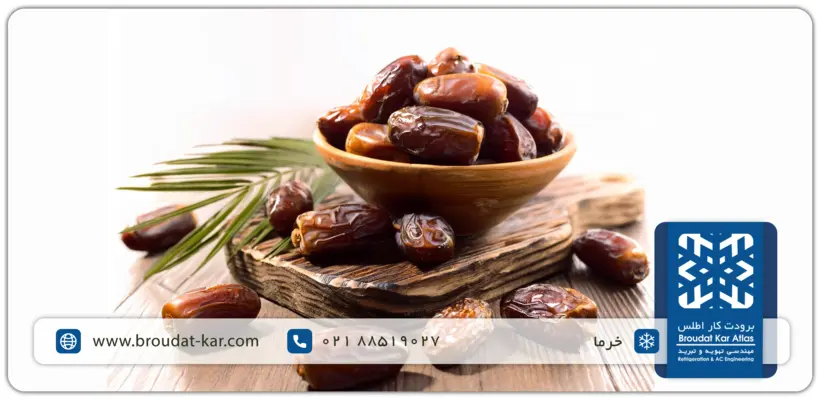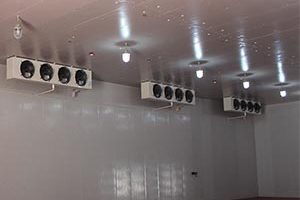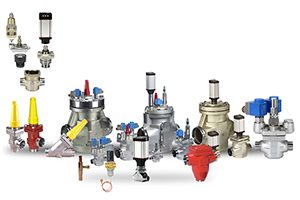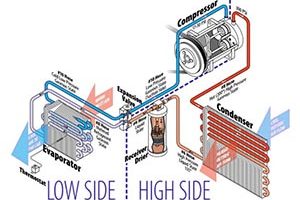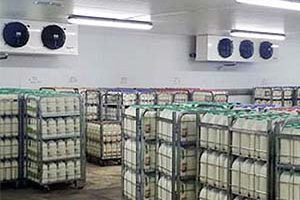Date Cold Storage
Dates are a delicious yet highly perishable fruit, especially in humid conditions where they spoil more quickly. Therefore, the storage conditions in cold rooms and warehouses are crucial. A “Date Cold Room” must meet specific standards in terms of temperature and humidity, tailored to the variety of dates being stored. When these conditions are optimized, dates can be stored in refrigeration for up to a year or even longer. In this article, we will provide a comprehensive overview of date cold storage, including proper maintenance conditions and associated costs.
What is Date Cold Storage?
In simple terms, date cold storage refers to a controlled environment where optimal conditions are maintained to preserve the quality of dates. These conditions include proper humidity, temperature, cleanliness, and ventilation. Cleanliness is especially crucial, as any contamination, suspended particles, or microorganisms can lead to the quick spoilage of dates.
Additionally, the cold storage environment must be well-insulated to prevent the entry of viruses, bacteria, or any pathogens, with measures in place to inhibit microbial growth. Proper lighting is also essential inside the storage area to easily detect insects or pests. Workers handling dates in cold storage should follow strict hygiene protocols to avoid contamination.
Due to the high sugar and moisture content in dates, they are particularly susceptible to pests. Storing them in a cold environment helps prevent changes in color and taste, quality degradation, mold growth, and pest infestation. Moreover, during high-demand periods such as Ramadan, storing dates in cold storage ensures availability and maintains their nutritional value.
Types of Cold Storage for Dates
Date cold storage can generally be categorized into two types based on storage temperature
- Cold Storage for Dry Dates (Above Zero): This type of storage maintains a temperature between 0 and 5 degrees Celsius, ideal for short-term storage. It helps prevent the rapid spoilage of dates while preserving their freshness.
- Cold Storage for Moist Dates (Below Zero): For long-term storage, cold storage units are used with temperatures below zero degrees Celsius, typically ranging between -3 and -18 degrees Celsius. These lower temperatures ensure that the dates maintain maximum quality over extended periods.
Date Storage Method and Conditions
With over 93 varieties of dates produced in Iran, each type requires specific storage conditions to maintain quality. For instance
- Honey Dates have a higher moisture content compared to other varieties, making them more prone to spoilage. Therefore, they require much lower storage temperatures than drier varieties.
- Zahedi Dates, on the other hand, are usually stored for shorter periods. Over time, they can attract insects, necessitating brief storage durations.
Key guidelines for optimal date storage include:
- Temperature Control: The cold room temperature must be carefully controlled, avoiding sudden fluctuations, which can accelerate spoilage. Ideally, dates should be harvested in the early morning when temperatures are lower and transferred to the cold room without delay.
- Ventilation: Proper and standard ventilation is essential. Fresh air should circulate uniformly through all shelves, ensuring consistent airflow across the stored dates.
- Shelf Spacing: Ensure that there is adequate space between shelves and products to allow unobstructed airflow.
- Hygiene Maintenance: The cleanliness of the cold storage environment is crucial. Regular checks for adequate lighting, appropriate employee hygiene, and other sanitary measures must be enforced.
- Appropriate Storage Duration: Each variety of date should be stored for the optimal period of time, neither too long nor too short, to preserve its freshness and quality.
| Description | Suitable Range | Agent |
| For short-term storage and maintaining the appearance quality of dry dates | 0to+5°C | Temperature |
| For long-term storage and to prevent spoilage of Shahdad or Rotab dates | 3to-18°C- | |
| Maintain proper humidity to prevent dates from drying out or becoming moldy | 60%to70% | Relative Humidity |
| Preventing the creation of hot and cold spots and the accumulation of moisture | Suitable and uniform | Air circulation |
| Avoid contamination and physical damage | Hygienic and impermeable | Packaging |
| Preventing color change and quality reduction | Dark | Light |
Optimal Temperature and Duration for Storing Dates in Cold Storage
To store various types of dates in the short term, cold storage temperatures are typically set between -5 and +5°C. Both the type of date and the storage duration play a key role in determining the ideal temperature for the cold storage.
Recommended temperatures based on storage duration:
- -18°C: Suitable for storing dates for one year or longer.
- -3°C: Ideal for storing dates for up to 6 months.
- 0 to +5°C: Best for storing dates for less than 3 months.
Types of Dates and Their Optimal Storage Conditions
Iran produces a wide variety of dates, each with unique characteristics and storage requirements. Here are some of the most important and well-known types of dates in the country:
- Mazafati: A popular type, cultivated in Kerman and Sistan & Baluchistan provinces.
- Zahedi: Known for its thin skin and small kernel, mainly grown in Kerman and Fars.
- Pyaram: A large, high-quality date primarily from Bushehr and Kerman provinces.
- Kabkab: Soft and sweet, cultivated in Khuzestan and Bushehr.
- Astamran: Known for its long shelf life, grown in Khuzestan and Hormozgan.
- Dayeri: Sweet and soft, harvested in Bushehr.
- Barhi: Small but sweet, cultivated in southern provinces.
- Majol: A premium and expensive date, grown in limited regions in Iran.
Below is a table summarizing the storage tips, humidity requirements, and major cultivation provinces for each variety:
| Important Maintenance Tips | Suitable Relative Humidity (%) | Major Provinces of Cultivation | Date Type |
| Sensitive to high humidity, requires proper packaging. | 70-75 | Bushehr, Kerman | Pyaram |
| Long shelf life, needs proper ventilation. | 65-70 | Mazafati | |
| Thin skin, sensitive to pressure. | 60-65 | Kerman, Sistan and Baluchistan | Zahedi |
| Hygrophilous, must be packed in sealed containers. | 70-75 | Khuzestan, Bushehr | Kabkab |
| Long shelf life, needs proper ventilation. | 65-70 | Bushehr, Fars | Astamran |
| Thick skin, very durable, high quality. | 60-65 | Hormozgan (limited cultivation) | Majol |
| Moisture-loving, sweet, requires proper packaging. | 70-75 | Bushehr | Dairi |
| Sensitive to humidity, should be stored in a dry cold room. | 60-65 | Fars | Shahani |
Methods of Packing Dates for Cold Storage
There are various types of dates in the Iranian market, such as Kabkab, Pyaram, Mozafati, Zahedi, Rabi, and Shahani, each with its own specific packaging method. Generally, dates are packed using either traditional or modern techniques:
Traditional Packaging:
In this method, dates are manually placed into high-quality plastic boxes or containers by human labor. This approach is becoming less common due to the potential for damage to the texture of the dates.
Modern Packaging:
With modern methods, dates are packed using advanced industrial equipment and then sealed using glue, staples, or other techniques. Bulk or band roll packaging methods may also be employed for larger quantities.
Comprehensive Process of Packing Dates for Cold Storage
Dates undergo several critical steps before reaching cold storage. Each stage must be carefully executed to ensure quality preservation. Here’s a detailed overview of the packing process from start to finish:
Harvesting Dates
In this initial step, date fruits are separated from the palm. While it’s easy to assess color and ripeness during harvesting, the internal moisture content or sugar levels require laboratory testing for accurate evaluation. Dates can be harvested at various growth stages, including thaleel, rutb, and tamar, depending on weather conditions, market demand, and date variety.
Transfer to the Production Line
After harvesting, dates should be swiftly transported to the production line using suitable vehicles. It’s crucial that these dates are placed in hygienic, disinfected containers to avoid contamination. The transport vehicle must also be disinfected and equipped with cooling systems to prevent spoilage.
Washing and Disinfection
Dates are disinfected using specialized equipment under the supervision of the Plant Protection Organization. This step eliminates harmful microorganisms. Concurrently, humidity adjustments are made based on the date variety, involving washing with clean drinking water and drying with dehumidifiers.
Storing Dates
Prior to packing, dates are temporarily stored in plastic baskets within cold rooms. Preventive measures against pests are essential at this stage, including the use of pheromones for trapping insects, local disinfection, gasification, or irradiation.
Date Sorting
In this step, dates are sorted based on size, color, shape, weight, or quality, a process known as grading. Sorting enhances the final product’s quality, increases its market value, and ensures uniformity in appearance and quality.
Date Packaging
In the final stage, dates are packaged according to Iranian national standard number 5998. The packaging must be pest-proof and compatible with the type of disinfection performed. For instance, polypropylene packaging is preferable for dates sterilized through irradiation.
Essential Equipment for Date Cold Storage
The main components of a date cold storage facility include the compressor, condenser, evaporator, insulation, and door. Here’s a closer look at each of these vital elements:
Compressor
The compressor is crucial for compressing the refrigerant, enabling the cooling process in the refrigeration cycle. Opting for a high-quality compressor from a reputable brand can enhance durability and lifespan, and it’s important to consider warranty options.
Condenser
As a fundamental component of any refrigeration system, the condenser’s primary role is to convert refrigerant vapor into liquid, facilitating the cooling process.
Evaporator
The evaporator transforms liquid refrigerant back into vapor, absorbing heat from the cold room’s environment. This process effectively lowers the temperature inside the storage, preserving the quality of the dates.
Insulation
Proper insulation is essential for maintaining the optimal internal temperature and extending the shelf life of dates. Advanced insulation materials like polyurethane or polystyrene panels help prevent heat transfer, reducing energy consumption and operational costs.
Cold Room Door
Typically sliding or hinged, the door of a date cold store must be designed to block insects and small animals while also providing adequate insulation to minimize energy loss.
Cost Factors of Date Cold Storage
The cost of establishing a date cold storage facility depends on various factors, with equipment pricing being one of the most significant. Here are some key factors affecting the overall price:
Cold Storage Capacity
The required storage capacity directly influences the size and power of the equipment, thus impacting costs.
Type and Quality of Equipment
Investing in modern, advanced equipment will increase upfront costs, and maintenance costs must also be considered for systems like cooling units and ventilation.
Geographical Location
Building a cold storage facility in tropical regions or areas with limited electricity access can lead to higher costs.
Construction Materials
Using high-quality building materials, especially for insulation, may raise initial expenses but can result in long-term savings on energy.
Purchasing Date Cold Storage
For acquiring a date cold storage solution, it’s advisable to consult reputable companies specializing in this field. With over 30 years of experience in the industry, we specialize in designing and constructing both small and industrial cold storage solutions, delivering high-quality systems equipped with the latest technology.
Our engineers provide support throughout the construction process, ensuring every aspect meets industry standards. In addition to cold storage, we also build freezing tunnels, ice systems, and distillation systems, offering expert advice to industrial manufacturers both domestically and internationally.
Atlas Refrigeration Services for Date Cold Storage
Atlas Refrigeration offers a complete suite of services for date cold storage, encompassing everything from initial design to after-sales support:
Design and Construction
We design and construct date cold storages that adhere to global standards, considering the specific type of dates, construction site, and required capacity. The construction process typically includes:
– Assessing the types of dates to be stored
– Evaluating the geographical location, including soil type and climate
– Calculating the refrigeration load for proper insulation and flooring
– Sourcing equipment from top brands and ensuring proper installation
– Conducting equipment testing and pre-launch procedures
After-Sales Service
Following the successful completion of the cold storage, performance tests are conducted before project handover. Clients receive comprehensive manuals detailing operation instructions, troubleshooting, and maintenance protocols. Our after-sales support lasts for 15 years, with 24/7 availability for any operational issues.
Warranty and Assurance
Atlas Refrigeration stands out by offering a One-Year Warranty on all constructed facilities, alongside 15 years of after-sales service, ensuring peace of mind for our valued clients.
Final Thoughts on Date Cold Storage
To maximize efficiency and prolong the shelf life of stored dates, it’s essential to minimize cooling time, maintain optimal humidity, and ensure adequate air circulation. Careful attention to energy optimization will also enhance overall performance.
Yes, different types of dates can be stored in the same cold storage. However, it’s recommended to separate them by type, quality grade, and harvest date. This helps prevent the transfer of taste and smell between different varieties and makes quality control easier.
Several factors can negatively impact the quality of dates, including temperature fluctuations, excess humidity, pests and insects, improper packaging, physical damage, and microbial contamination.
The ideal packaging depends on the type of dates, the storage duration, and market requirements. Common options include wooden or plastic boxes, polythene bags, and glass containers. The packaging should be made from high-quality, hygienic materials to prevent air, moisture, and pests from penetrating.
Yes, date cold storage facilities can also be used to store other agricultural products like fruits and vegetables, provided that the specific temperature and humidity requirements of each product are met. The cold storage should be equipped to handle various storage conditions.
Related posts
Date Cold Storage
Valves and Control Devices in Ammonia and Freon Refrigeration Systems The variety of valves and control devices in refrigeration systems
Cold Storage Equipment Cold storage equipment encompasses a variety of machines and devices specifically designed to store perishable goods at
What is Industrial Cold store? An industrial cold store is a large-scale facility designed and constructed to preserve and
